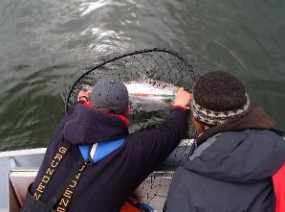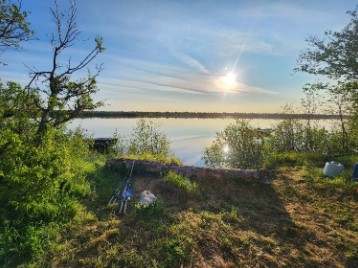Bristol Bay Management Area
Fishing Research
Sport Fishing Creel Surveys
Creel surveys are a tool often used in Bristol Bay to give inseason estimates of sport effort, often gaining information on catch and harvest rates at particular locations within a general area. They can assess angler gear types, residency, and establish whether anlgers are utilizing a guided service or not, and give the opportunity to gather biological data from sport harvested fish while interviewing anglers.
Recent Creels include:
- The Nushagak River for King Salmon (2023)
- The Naknek River for Coho Salmon (2023)
- The Naknek River for King Salmon (2022)
- The Togiak River for King Salmon (2021)
- The Nushagak River for Coho Salmon (2021)
Catch and Release Mortality King Salmon
King Salmon were tagged with radio transmitters in the lower Nushagak River using sport fishing gear commonly used in the inriver fishery to determine short term (5 day) catch and release mortality rates. Esophageal implant radio transmitters were inserted into some king salmon. Survival and movement of radio tagged salmon were monitored by daily aerial surveys, boat surveys, and two stationary tracking stations to determine fate. A mortality rate of 6.7% was determined through this study.
Nushagak King Creel Project
The Nushagak River is located in Southwestern Alaska and flows approximately 390 km (242 miles) from its headwaters into Bristol Bay. The Nushagak River drainage supports the largest sport fisheries for king salmon in the Bristol Bay Management Area (BBMA). Since the summer of 1985 the Division of Sport Fish has used creel surveys to monitor the sport fisheries present in the Nushagak to gather in-depth information on inseason estimates of sport effort, catch and harvest rates; while assessing angler gear, residency, and if anglers are guided; and allows staff to gather biological data from sport harvested fish. King salmon arrive at the Nushagak District earlier than sockeye salmon, but there is substantial overlap in their run timing from late June through July. King salmon pass through the district from early June to late July; with the peak of the run historically occurring from June 19 through July 3. Sport Fish Division staff establish a field camp along the banks of the Nushagak River and survey six days a week during the months of June and July.
A creel conducted in 2019 showed an average length of 679.2mm (mid eye to tail fork) compared to the 2023 creel survey that showed an average of 597.7mm. The largest king measured during this time frame was 945 mm (mid eye to tail fork) which is roughly 37 inches, measured in 2023. The slight decrease of average length in the sport harvest could be due to new regulations that went into effect for the 2023 season, allowing 1 fish over 28" to be harvested, with an annual bag limit of 4 for Nushagak kings as opposed to 4 fish over 28" inches allowed annually prior to the designation of Nushagak king salmon as a stock of management concern.
A multiyear project was initiated in June 2023 to focus on providing an in-season representation of the sport fishery and rates of catch and harvest on the Nushagak, with a glimpse into the general health of the returning kings. This project will create a source of reference data on in-river king numbers to be used alongside the Portage Creek Sonar data to help area managers better understand king abundance and composition.



